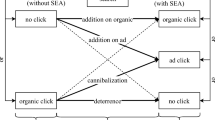Abstract
Sponsored search is a multi-billion dollar market. Determining which characteristics of sponsored search campaigns are associated with campaign success has been an active research field, particularly in the consumer retail industry. We develop and examine a theoretical model that integrates and extends established theories of information content, persuasive content, emotion, and style of advertising in traditional media (print, television) to online advertising. We analyze the determinants of sponsored search success across multiple sub-industries in the long term subscription market, with data on four companies who sell long term subscription services with monthly recurring revenue. We use structured equation modeling to test a model that relates bid content features to the average position and number times an ad is displayed (i.e., impressions) in search engine results. In turn, the average position and number of impressions, together with the ad content features, influence the number of times that consumers will click on an ad. The results, based on the magnitude of path coefficients for all companies (i.e., brands), show that average position and total impressions (which are influenced by bid characteristics) have a far stronger effect on clicks than the impact of ad characteristics. The content analysis study undertaken here vividly illustrates that the effects of information content, persuasive content, emotion, and style on advertisement clicks are highly diverse across brands. This suggests the need for future research on brand, product, and consumer-specific factors that influence clicks, and further research on automated tools that provide tailored content optimization guidance to online campaign managers.





Similar content being viewed by others
References
Abernethy AM, Franke GR (1996) The information content of advertising: a meta-analysis. J Advert 25(2):1–17
Agarwal A, Hosanagar K, Smith M (2011) Location, location, location: an analysis of profitability of position in online advertising markets. J Market Res 48(6):1057–1073
Agresti A (1990) Categorical data analysis. Wiley, London
Anderson C (2006) The long tail: why the future of business is selling less of more. Hyperion
Anderson JC, Gerbing DW (1988) Structural equation modeling in practice: a review and recommended two-step approach. Psychol Bull 103(3):411–423
Babin BJ, Darden WR, Griffin M (1994) Work and/or fun: measuring hedonic and utilitarian shopping value. J Consum Res 20(4):644–656
Benbasat I, Goldstein DK, Mead M (1987) The case research strategy in studies of information systems. MIS Q 11(3):369–386
Bertrand M, Karlan D, Mullainathan S, Shafir E, Zinman J (2010) What’s advertising content worth? Evidence from a consumer credit marketing field experiment. Q J Econ 125(1):263–306
Bradley MM, Lang PJ (2010) Affective norms for English words (ANEW): instruction manual and affective ratings. Technical report C-2, The Center for Research in Psychophysiology, University of Florida
Broder A, Ciccolo P, Gabrilovich E, Josifovski V, Metzler D, Riedel L, Yuan J (2009) Online expansion of rare queries for sponsored search. In: Proceedings of the 18th International World Wide Web Conference
Cohen J (1960) A coefficient of agreement for nominal scales. Educ Psychol Meas 20(1):37–46
Cusumano MA (2008) The changing software business: moving from products to services. Computer 41(1):20–27
D’Arcy J, Hovav A, Galletta D (2009) User awareness of security countermeasures and its impact on information systems misuse: a deterrence approach. Inf Syst Res 20(1):79–98
D’Avanzo E, Kuflik T, Elia A (2011) Online advertising using linguistic knowledge. In: D’Atri A et al (eds) Information technology and innovation trends in organizations. Springer, Berlin
Deane J, Pathak P (2009) Ontological analysis of web surf history to maximize the click-through probability of web advertisements. Decis Support Syst 47(4):364–373
Diamantopoulos A, Winklhofer H (2001) Index construction with formative indicators: an alternative to scale development. J Market Res 37:269–277
Dubey A, Wagle D (2007) Delivering software as a service. McKinsey Quarterly 6:1–12
Edelman B, Ostrovsky M, Schwarz M (2007) Internet advertising and the generalized second-price auction: selling billions of dollars worth of keywords. Am Econ Rev 97(1):242–259
Eisenhardt KM (1989) Building theories from case study research. Acad Manag Rev 14(4):532–550
Fain DC, Pedersen JO (2005) Sponsored search: a brief history. ASIS Bull (Bulletin of the American Society for Information Science and Technology), Special Section, December 2005/January 2006
Flesch R (1948) A new readability yardstick. J Appl Psychol 32(3):221–233
Flesch R (1951) How to test readability. Harper, New York
Fox C (1989) A stop list for general text. ACM SIGIR Forum 24(1–2):19–21
Gefen D, Straub DW, Boudreau M-C (2000) Structural equation modeling and regression: guidelines for research practice. Commun Assoc Inf Syst 4(7):1–70
Ghose A, Yang S (2009) An empirical analysis of search engine advertising: sponsored search in electronic markets. Manage Sci 55(10):1605–1622
Google Inc (2012) Quality Score—AdWords Help. http://support.google.com/adwords/bin/answer.py?hl=en&answer=2454010. Accessed on 14 September 2012
Google Inc (2014) Using keyword matching options. https://support.google.com/adwords/answer/2497836?hl=en. Accessed on 22 March 2014
Graepel T, Candela JQ, Borchert T, Herbrich R (2010) Web-scale bayesian click-through rate prediction for sponsored search advertising in Microsoft’s Bing Search Engine. In: Proceedings of the 27th International Conference on Machine Learning ICML 2010
Hair JF, Hult GTM, Ringle CM, Sarstedt M (2014) A primer on partial least squares structural equation modeling. Sage, Thousand Oaks
Hair JF, Ringle CM, Sarstedt M (2011) PLS-SEM: indeed a silver bullet. J Market Theory Pract 19(2):139–151
Jansen BJ, Mullen T (2008) Sponsored search: an overview of the concept, history, and technology. Int J Electron Bus 6(2):114–131
Jansen BJ, Schuster S (2011) Bidding on the buying funnel for sponsored search campaigns. J Electron Commer Res 12(1):1–18
Jansen BJ, Sobel K, Zhang M (2011) The brand effect of key phrases and advertisements in sponsored search. Int J Electron Commer 16(1):77–106
Jarvis CB, MacKenzie SB, Podsakoff PM (2003) A critical review of construct indicators and measurement model misspecification in marketing and consumer research. J Consum Res 30(2):199–218
Kassarjian HH (1977) Content analysis in consumer research. J Consum Res 4(1):8–18
Kelly E, Stone P (1975) Computer recognition of English word senses, North-Holland Linguistic Series, 1975
Li J, Pan R, Wang W (2010) Selection of best keywords: a poisson regression model. J Interact Advert 11(1):27–35
Mahdian M, Tomak K (2008) Pay-per-action model for on-line advertising. Int J Electron Commer 13(2):113–128
Naccarato JL, Neuendorf KA (1998) Content analysis as a predictive methodology: recall, readership, and evaluations of business-to-business print advertising. J Advert Res 38(3):19–33
Neuendorf KA (2002) The content analysis guidebook. Sage Publications, Thousand Oaks
Nielsen F (2011) A new ANEW: evaluation of a word list for sentiment analysis in microblogs. In: Proceedings of the ESWC2011 Workshop on Making Sense of Microposts: big things come in small packages, pp 93–98
PriceWaterHouseCoopers (2013) IAB internet advertising revenue report, 2013 first six months’ results. October 2013. http://www.iab.net/media/file/IABInternetAdvertisingRevenueReportHY2013FINALdoc.pdf
Ramalingam V, Palaniappan B, Panchanatham N, Palanivel S (2006) Measuring advertisement effectiveness—a neural network approach. Expert Syst Appl 31(1):159–163
Resnik A, Stern BL (1977) An analysis of information content in television advertising. J Market 41(1):50–53
Richardson M, Dominowska E, Ragno R (2007) Predicting clicks: estimating the click-through-rate for new ads. In:Proceedings of the International World Wide Web Conference (WWW 2007), ACM, Banff, Alberta, Canada, May 8–12, 2007
Robinson H, Wysocka A, Hand C (2007) Internet advertising effectiveness: the effect of design on click-through rates for banner ads. Int J Advert 26(4):527–541
Rosso MA, Jansen BJ (2010) Brand names as keywords in sponsored search advertising. Commun Assoc Inf Syst 27(1):6
Rutz OJ, Bucklin RE (2007) A model of individual keyword performance in paid search advertising. Working paper, Yale University, New Haven, CT. June
Rutz OJ, Trusov M, Bucklin RE (2011) Modeling indirect effects of paid search advertising: which keywords lead to more future visits? Market Sci 30(4):646–665
Shaparenko B, Çetin Ö, Iyer R (2009) Data-driven text features for sponsored search click prediction. ADKDD ‘09: Proceedings of the Third International Workshop on Data Mining and Audience Intelligence for Advertising, 46–54
Spears N (2001) Time pressure and information in sales promotion strategy: conceptual framework and content analysis. J Advert 30(1):67–76
Stone PJ, Dunphy DC, Smith MS, Ogilvie DM (1966) The general inquirer: a computer approach to content analysis. MIT Press, Cambridge
Thelwall M, Buckley K, Paltoglou G, Cai D, Kappas A (2010) Sentiment strength detection in short informal text. J Am Soc Inf Sci Technol 61(12):2544–2558
Thelwall M, Buckley K, Paltoglou G (2012) Sentiment strength detection for the social Web. J Am Soc Inf Sci Technol 63(1):163–173
Yin RK (1989) Case study research. Sage Publications, London
Author information
Authors and Affiliations
Corresponding author
Appendices
Appendix 1: description of custom taxonomy
Table 4 provides a mapping of the custom taxonomy for ad and bid words, used in this paper, to prior research. Numeric columns are as follows: Occurrences = The number of appearances of the word across all bids and ads (including ad title and ad text); Uniques = The number of unique words in this category, in the data set; Frequency = the number of times, on average, each unique word from this class was used across all bids and ads (Frequency = Occurrences ÷ Uniques). The table is sorted in descending order from categories with most word occurrences in the data set, to those with least. Categories omitted from our model are shown italicized in Table 4—these categories are omitted as they occur too infrequently to allow significant, generalizable conclusions to be drawn.
“Information Content” categories from Resnik and Stern [44] and Abernethy and Franke [1] which do not appear in our taxonomy were:
-
Taste, Nutrition, and Packaging were omitted as these categories are appropriate to retail goods, but not to subscription services.
-
Warranties, Safety, Independent Research, Company Research, and New Ideas were omitted as there were no appearances of these categories in our data set; Resnik and Stern considered hardcopy advertisements that had greater word count than sponsored search advertisements (typically less than 12 words); sponsored search advertisements in our sample appear to omit these categories for lack of space.
Appendix 2: sentiment extraction
This appendix gives descriptions of General Inquirer, ANEW, AFFIN, and SentiStrength dictionaries used for sentiment extraction. The columns in Table 5 are as follows:
-
Dictionary: the name of the metric
-
#: the number of lexical entries in the metric in the dictionary
-
Scale: the basis of scale the scale-minimum and maximum score for each word in the dictionary
-
Description: a brief description of the metric
-
Coverage: the percentage of bids/ads in the data set for which a non-neutral score is obtained for this metric. Low coverage indicates the metric is not helpful for describing a majority of the campaigns in the data set. We describe coverage, rather than simply ‘missing values’ or ‘non-zero values’, because SentiStrength measures neutral as +1 or −1. As +1 or −1 are both neutral values (but would not be counted as missing or non-zero), we specify coverage as non-neutral values.
Appendix 3: descriptive statistics and histograms
Tables 6 and 7 report descriptive statistics and histograms, respectively, for the variables in this study. Table 6 shows descriptive statistics for the portion of the data set that had no missing values that was used for PLS (15,658 records). The histograms in Table 7 show distributions for the original complete data set (25,582 records). In Table 6, data is omitted (marked as “Insufficient data”) for variables which had missing values for more than 99.5 % of bids, which had missing values for more than 99.5 % of ads, or which had insufficient occurrences (as per “Appendix 1”).
Rights and permissions
About this article
Cite this article
Abrahams, A.S., Barkhi, R., Coupey, E. et al. Converting browsers into recurring customers: an analysis of the determinants of sponsored search success for monthly subscription services. Inf Technol Manag 15, 177–197 (2014). https://doi.org/10.1007/s10799-014-0186-0
Published:
Issue Date:
DOI: https://doi.org/10.1007/s10799-014-0186-0




